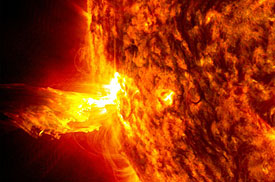INL News Release
FOR IMMEDIATE RELEASE
April 7, 2015
NEWS MEDIA CONTACTS:
Misty Benjamin, 208-351-9900, [email protected]
Emily Nichols, 208-526-5111, [email protected]
Idaho hosts national conversation on protection of nation’s power grid
IDAHO FALLS – Utility leaders, lawmakers and researchers gather in Idaho Falls this week to discuss national recovery and potential risks associated with restoring services following a large-scale geomagnetic disturbance, such as the March 1989 storm that resulted in loss of power to 6 million Hydro-Québec customers.
A National Academy of Sciences report estimates that a worst-case geomagnetic storm could have an economic impact of $1 trillion to $2 trillion in the first year, which is 20 times the damage caused by a Katrina-class hurricane. The estimates are based on digital prediction models funded by the National Academy of Sciences and others.
“We are interested in taking a closer look at the challenges posed by a geomagnetic disturbance,” said Scott McBride, Infrastructure Security Department manager at the U.S. Department of Energy’s Idaho National Laboratory. “We are taking a proactive approach to discuss building resilience into the power infrastructure to avoid some of the damage that could occur.”
A year ago, INL announced the result of a full-scale testing effort sponsored by the U.S. Department of Defense’s Defense Threat Reduction Agency (DTRA) and in collaboration with Scientific Applications & Research Associates Inc. and Baylor University. Researchers at Idaho National Laboratory modeled and validated these phenomena, confirming some geomagnetic storm theories and bringing new concerns to light.
“INL’s tests demonstrated the strength of geomagnetic-induced currents and the resulting harmonics,” McBride said. “Advanced planning may help us to prevent unexpected shutdown that damage systems and may lead to socio-economic impacts, injuries, fatalities, serious business disruption and/or data loss.”
The goal of the workshop is to bring together key stakeholders to evaluate actions that may mitigate the damage caused by a major geomagnetic disturbance. Participants are working to address resilience and the power needs of the nation, while balancing the effort with a reasonable and affordable path forward.
The U.S. power grid is made up of complex and expensive system components, which are owned by utilities ranging from small municipalities to large national corporations spanning multiple states. Utilities often take years to plan for major upgrades or repairs to their power systems.





